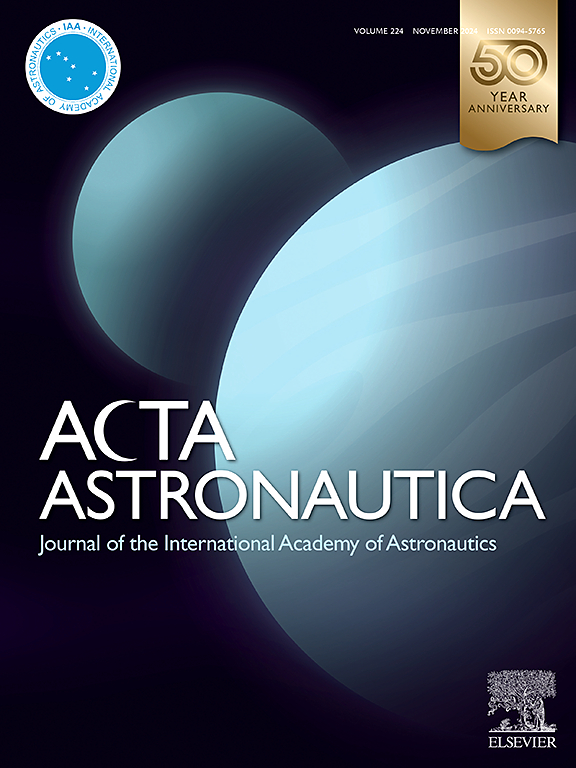Flame acceleration and detonation initiation process over porous flat wall
IF 3.4
2区 物理与天体物理
Q1 ENGINEERING, AEROSPACE
引用次数: 0
Abstract
The flame acceleration process and detonation initiation process of the ethylene and oxygen-rich air mixture over porous flat wall are experimentally studied using high-speed photography technology. The results show that there are two flame acceleration modes over porous flat wall with four pore densities. The flame acceleration over porous flat wall with small pore density (10ppi and 30ppi) is driven by the high velocity flame inside the porous media. Regarding the porous flat wall with larger pore density (40ppi and 50ppi), the flame undergoes an initial acceleration process inside the porous media, following by the further acceleration due to the joint effects of rough wall disturbance and mainstream in the detonation tube. The distance for laminar flame to accelerate to 0.5CJ (Chapman-Jouguet) velocity is 55 mm and 100 mm over porous flat walls with small pore density and large pore density, respectively. To reveal the detail acceleration magnitude of the flame in the porous media, different porous media obstacles are set in the tube. The laminar flame accelerates to a maximum velocity of approximately 300 m/s in large pore density porous obstacles. While in smaller pore density porous obstacles, the maximum flame velocity is much higher. Regarding the detonation initiation, it is found to be triggered by the local explosion generated by the action of shock wave over porous flat wall with four pore densities. The smaller the pore density is, the closer the position of the local explosion is to the upstream detonation tube.
多孔平壁上火焰加速与起爆过程
利用高速摄影技术,实验研究了乙烯-富氧空气混合物在多孔平壁上的火焰加速过程和爆轰起爆过程。结果表明:在四种孔密度的平面多孔壁面上存在两种火焰加速模式。小孔密度(10ppi和30ppi)多孔扁平壁面上的火焰加速度是由多孔介质内部的高速火焰驱动的。对于孔径密度较大(40ppi和50ppi)的多孔平壁,火焰在多孔介质内经历初始加速过程,随后由于爆震管内粗壁扰动和主流的共同作用,火焰进一步加速。在小孔密度和大孔密度的多孔平壁上,层流火焰加速到0.5 5cj (Chapman-Jouguet)速度的距离分别为55 mm和100 mm。为了揭示火焰在多孔介质中的具体加速度大小,在管内设置了不同的多孔介质障碍物。在大孔隙密度的多孔障碍物中,层流火焰的最大速度可达300 m/s左右。而在孔径密度较小的多孔障碍物中,最大火焰速度要高得多。爆轰起爆是由激波作用在具有四种孔密度的多孔平壁上产生的局部爆炸引起的。孔密度越小,局部爆炸位置越靠近上游爆轰管。
本文章由计算机程序翻译,如有差异,请以英文原文为准。
求助全文
约1分钟内获得全文
求助全文
来源期刊

Acta Astronautica
工程技术-工程:宇航
CiteScore
7.20
自引率
22.90%
发文量
599
审稿时长
53 days
期刊介绍:
Acta Astronautica is sponsored by the International Academy of Astronautics. Content is based on original contributions in all fields of basic, engineering, life and social space sciences and of space technology related to:
The peaceful scientific exploration of space,
Its exploitation for human welfare and progress,
Conception, design, development and operation of space-borne and Earth-based systems,
In addition to regular issues, the journal publishes selected proceedings of the annual International Astronautical Congress (IAC), transactions of the IAA and special issues on topics of current interest, such as microgravity, space station technology, geostationary orbits, and space economics. Other subject areas include satellite technology, space transportation and communications, space energy, power and propulsion, astrodynamics, extraterrestrial intelligence and Earth observations.
 求助内容:
求助内容: 应助结果提醒方式:
应助结果提醒方式:


